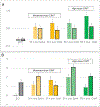Constraint-Induced Movement Therapy for Cerebral Palsy: A Randomized Trial
- PMID: 34649982
- PMCID: PMC11632840
- DOI: 10.1542/peds.2020-033878
Constraint-Induced Movement Therapy for Cerebral Palsy: A Randomized Trial
Abstract
Objectives: With the Children with Hemiparesis Arm and Hand Movement Project (CHAMP) multisite factorial randomized controlled trial, we compared 2 doses and 2 constraint types of constraint-induced movement therapy (CIMT) to usual customary treatment (UCT).
Methods: CHAMP randomly assigned 118 2- to 8-year-olds with hemiparetic cerebral palsy to one of 5 treatments with assessments at baseline, end of treatment, and 6 months posttreatment. Primary blinded outcomes were the assisting hand assessment; Peabody Motor Development Scales, Second Edition, Visual Motor Integration; and Quality of Upper Extremity Skills Test Dissociated Movement. Parents rated functioning on the Pediatric Evaluation of Disabilities Inventory-Computer Adaptive Test Daily Activities and Child Motor Activity Log How Often scale. Analyses were focused on blinded and parent-report outcomes and rank-order gains across all measures.
Results: Findings varied in statistical significance when analyzing individual blinded outcomes. parent reports, and rank-order gains. Consistently, high-dose CIMT, regardless of constraint type, produced a pattern of greatest short- and long-term gains (1.7% probability of occurring by chance alone) and significant gains on visual motor integration and dissociated movement at 6 months. O'Brien's rank-order analyses revealed high-dose CIMT produced significantly greater improvement than a moderate dose or UCT. All CIMT groups improved significantly more in parent-reported functioning, compared with that of UCT. Children with UCT also revealed objective gains (eg, 48% exceeded the smallest-detectable assisting hand assessment change, compared with 71% high-dose CIMT at the end of treatment).
Conclusions: CHAMP provides novel albeit complex findings: although most individual blinded outcomes fell below statistical significance for group differences, high-dose CIMT consistently produced the largest improvements at both time points. An unexpected finding concerns shifts in UCT toward higher dosages, with improved outcomes compared with previous reports.
Trial registration: ClinicalTrials.gov NCT01895660.
Copyright © 2021 by the American Academy of Pediatrics.
Conflict of interest statement
POTENTIAL CONFLICT OF INTEREST: The authors have indicated they have no potential conflicts of interest to disclose.
Figures




Comment in
-
Optimizing Constraint-Induced Movement Therapy for Children With Cerebral Palsy.Pediatrics. 2021 Nov;148(5):e2021053121. doi: 10.1542/peds.2021-053121. Epub 2021 Oct 14. Pediatrics. 2021. PMID: 34649981 No abstract available.
References
-
- Centers for Disease Control and Prevention. Data and statistics for cerebral palsy. Available at: https://www.cdc.gov/ncbddd/cp/data.html. Accessed October 2, 2020
-
- Odding E, Roebroeck ME, Stam HJ. The epidemiology of cerebral palsy: incidence, impairments and risk factors. Disabil Rehabil. 2006;28(4):183–191 - PubMed
-
- Novak I, McIntyre S, Morgan C, et al. A systematic review of interventions for children with cerebral palsy: state of the evidence. Dev Med Child Neurol. 2013;55(10):885–910 - PubMed

